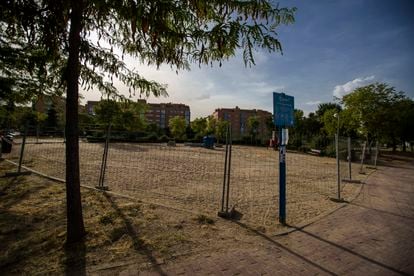30 years ago they were the reference point of each neighborhood.
Today many go unnoticed.
Others, more stealthy, have been resurrected after the pandemic.
The reality for everyone is that they are the great lungs of the neighborhood.
Municipal markets are part of an ecosystem in itself.
The big problems -both in Madrid, and in Barcelona, Seville or Valencia- are common.
If the City Councils do not get involved in these commercial spaces, their poor condition and the competition from large surfaces opens up a process of losing customers and stalls.
In the case of the capital of Spain it is evident.
There are two neighbourhoods, for example, that have been dreaming of a municipal market for decades.
In Las Tablas, where about 40,000 residents live north of the capital, the popular mayor Alberto Ruiz Gallardón promised and approved a municipal market back in 2008. Fourteen years later, the result is the same: a wasteland.
Weeds grow everywhere on the promised plot.
Garbage reigns supreme.
Inside, the young people circulate in the afternoons with their skateboards, right next to a municipal metal barracks where the elderly people of the neighborhood put the air conditioning at 17 degrees so that the temperature inside is acceptable and reaches, at least , 28 or 30. The usual: Madrid is not the center.
There is one in each of the 21 districts.
"Demand has not changed in these 14 years," says Lorenzo Álvarez, the president of the Las Tablas neighborhood association.
“They promise and promise and do nothing.
Gallardón promised and here we continue.
Now we have 40,000 workers who come to work in our neighborhood daily and would be nourished by the market.
We only have one Save More and two Mercadonas, but the problem is that we don't have fresh products.
We are doomed to go out to these warehouses.”
The councilor and spokesperson for the Economy of the socialist group, Enma López, will pose a question this Monday to her municipal counterpart, the mayor of Ciudadanos, Miguel Ángel Redondo, during the Economy commission: “What measures does your government area have planned to reduce the deficit of municipal markets that the city has?
A market for every 74,100 people
López has elaborated a detailed study of the capital's markets.
Madrid now has a network of 45 municipal food centers for a population of 3.3 million inhabitants.
A market for every 74,100 people.
"No new market has been built in this century, and the municipal government has no plans to do so again," he says during a walk through the Las Tablas area.
"What's more, Madrid has lost municipal markets [Olavide,
Miguel, Torrijos, Atocha, more recently Orcasur], and has several with very few open positions: Bami, San Cristóbal”.
The socialist spokeswoman also considers that they are very poorly distributed.
"The district of Centro has six municipal markets, but four districts with a total of 651,255 people have none [San Blas-Canillejas, Fuencarral-El Pardo, Barajas and Hortaleza]," she says.
Of the 131 neighbourhoods, only 42 of them have a municipal market, but the remaining 89 neighbourhoods, which are home to 62.5% of the population, lack this municipal facility.
Barcelona, however, has 39 municipal food markets and another four non-food markets for a population that is half that of Madrid.
The Catalan city has a municipal market for every 38,050 people, spread over its ten districts.
“In all there is at least one”, emphasizes López.
According to its Strategic Market Plan (2015-2025), the objective is to ensure that everyone has a municipal market less than 10 minutes' walk from their home.
"His thing would be for more municipal markets to open, but better thought," Javier Ollero, the president of the Federation of Grouped Commerce and Markets of the Community of Madrid, tells by phone.
“We have fierce competition.
What interests us now is to remove us from the market”.
Plot in the Sanchinarro neighborhood where there is a children's area instead of a market.Luis Sevillano
Another striking case is the neighborhood of Sanchinarro, where another municipal plot is at ease, empty, surrounded by ferns and fenced, as if some neighbor was tempted to enter.
"It's another promise that has ended up being a chimera," recalls the socialist mayor López.
“When they sold us the first houses in 2003 and 2004″, points out the president of the neighborhood residents' association, Socorro Sáez, “the construction companies showed us a video where there was everything, including a market.
Today, however, there is nothing.
We only have El Corte Inglés and very few stores.
It's always the same.
Politicians promise and promise and they are only words.
Many of the families that are here came with children, they put swings for us, but now they are teenagers and need sports centers and sports areas, but they don't have them”.
― And where are they going?
“To other neighborhoods.
They have to get out of here.
Subscribe here
to our daily newsletter about Madrid.


/cloudfront-eu-central-1.images.arcpublishing.com/prisa/4BHRE2HHXNDYDPNRKN7GO7PTDY.jpg)

/cloudfront-eu-central-1.images.arcpublishing.com/prisa/WPSTFCV5ENDWTMJAHJJ5FBRZ5Y.jpg)
/cloudfront-eu-central-1.images.arcpublishing.com/prisa/ITNJYP4IXVBO3C5JPHUJOLXY54.jpeg)
/cloudfront-eu-central-1.images.arcpublishing.com/prisa/SGKVBRGU7FC7PHC466NFXMSVTM.jpg)
/cloudfront-eu-central-1.images.arcpublishing.com/prisa/G7CUGFSSVJCUFFL6Q5HHVTTC4Y.jpg)







